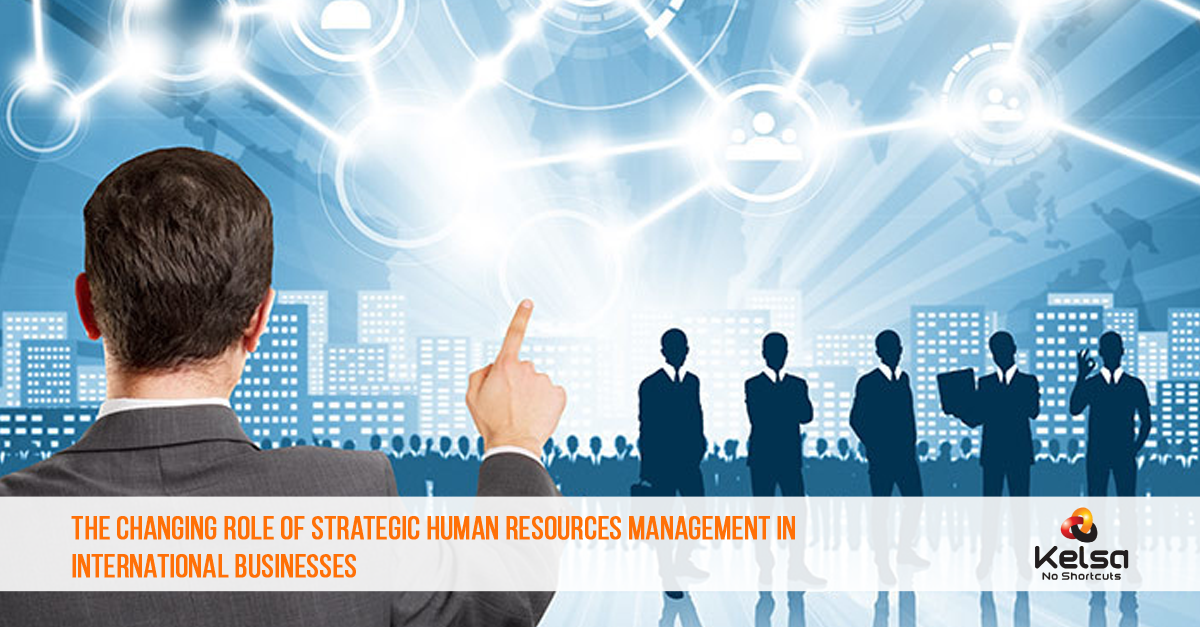Evolving Strategic HRM to Grow and Expand International Businesses

Over the past couple decades, with increased globalisation and technology enablement businesses of all sizes – micro, small, medium and large, have all had to respond to the unprecedented need for growth, market access and expansion. And the race for each of them is not just defined around getting to the top – rather, it’s built over gaining wide market reach, developing deep localised connect, and staying nimble and responsive to multiple market and policy influences.
Understandably, these landscapes demand HR partnership that extends well beyond the facilitation of administrative and routine people support, to a well-layered strategic alignment with business needs. Strategic HRM (SHRM) practices today are evolving rapidly to enable these goals and guide managers to think more broadly and deeply about employee participation in driving organisational success.
International businesses are adopting SHRM measures and investing in high-performance work systems to enable increased employee participation and equitable access to information and development opportunities. These measures also help create increased financial performance and shareholder value across the markets they operate.
Planning Strategic HRM Objectives
While defining SHRM measures to expand their global presence and outperform competitors, it pays for companies to evaluate and develop a well-defined set of objectives. In his book Delivering Results, David Ulrich recommends that companies evaluate the following to align their efforts better –
- Competence – the extent to which the company has the requisite knowledge, skills and abilities to ensure SHRM implementation
- Consequence – the extent to which the right measures, rewards, and incentives are in place to align people’s efforts with the company strategy
- Governance – the availability of appropriate structures, communications systems, and policies to build a high-performing organisation
- Learning and Leadership – ability to respond to uncertainty, as well as learn and adapt to change quickly
After evaluating the above companies could invest in the following areas to maximise employee performance across international markets.
Talent Acquisition
Recruiting the right talent, and ensuring that new hires into the company are well acquainted with the company’s global business objectives is vital to building a committed workforce that delivers within expanding/transformative environments. While aligning new hires with growth mandates, companies will need to focus on –
- offering in-depth exposure to the nature of their jobs including technical competencies and success factors
- ensuring behavioural competencies are well defined, for instance, empathy and connect, strong customer and work-management focus, and the ability to take tasks through completion or seek collaboration where needed
- clarifying values that underpin the organisation’s culture and allowing employees to interact with ‘ambassadors’ within the organisation who inspire and embody such values
Enhanced Learning
The ability to synchronise planning and delivery across divisions and geographies is a key success factor for companies growing rapidly across borders.
Creating opportunities for enhanced learning and encouraging employee participation in global projects helps with the rapid transfer of knowledge, skills and capabilities. With greater opportunities created for them to work together, employees also get better at identifying synergies and aligning their efforts to ensure delivery and impact. Further, it helps drive visibility on the “bigger picture” and empowers them to place their roles in context with the broader organisational goals, while driving action and impact.
Equity in Reward and Benefits Structure
Delivering equitable reward and benefits structure that is consistent across geographies, and yet well aligned to local market conditions is a key priority within international companies.
It is important they develop reward structures that emphasise and support employee ownership in skill development, teamwork and collaboration, and incentivise employees to consistently gain skills that add value to the organisation. As employees feel rewarded for acquiring a broad range of skills, they are likely to apply them more, feel more satisfied with their jobs, and demonstrate greater commitment to the organisation.
Diversity and Connect
Fostering diversity is a key SHRM objective as it enables innovativeness and problem-solving capabilities. Experts on the subject assert that increased diversity with regards to age, gender, expertise, background and abilities, helps minimises group think and improves problem-solving capabilities within organisations. Further, diversitymeasures also help teams to generate complementary skills and deliver creative and effective solutions.
Aside from diversity, establishing localised connect is a key enabler within international companies, and enhances their ability to anchor their products and services across different markets.
When localised connect is achieved through joint ventures or acquisitions, HR leaders will need to be sensitive to differences in culture and practices from the parent organisation, and drive measures to sensitise teams, and foster transparency and communication. Implementing a transition plan and ensuring cultural sensitivity from the very beginning will help structure positive actions, send out the right messages, and ensure buy-in and support across all stakeholder groups.
In conclusion, effective SHRM measures can greatly influence the success of a company’s expanded international operations. With uniform HR initiatives and consistent standards laid down across markets, they help companies adapt better to global expansion and outperform competitors. Further, they drive their ability to invest in innovation, respond to changing global conditions and secure a high-performing international workforce.
Evolving Strategic HRM to Grow and Expand International Businesses

Over the past couple decades, with increased globalisation and technology enablement businesses of all sizes – micro, small, medium and large, have all had to respond to the unprecedented need for growth, market access and expansion. And the race for each of them is not just defined around getting to the top – rather, it’s built over gaining wide market reach, developing deep localised connect, and staying nimble and responsive to multiple market and policy influences.
Understandably, these landscapes demand HR partnership that extends well beyond the facilitation of administrative and routine people support, to a well-layered strategic alignment with business needs. Strategic HRM (SHRM) practices today are evolving rapidly to enable these goals and guide managers to think more broadly and deeply about employee participation in driving organisational success.
International businesses are adopting SHRM measures and investing in high-performance work systems to enable increased employee participation and equitable access to information and development opportunities. These measures also help create increased financial performance and shareholder value across the markets they operate.
Planning Strategic HRM Objectives
While defining SHRM measures to expand their global presence and outperform competitors, it pays for companies to evaluate and develop a well-defined set of objectives. In his book Delivering Results, David Ulrich recommends that companies evaluate the following to align their efforts better –
- Competence – the extent to which the company has the requisite knowledge, skills and abilities to ensure SHRM implementation
- Consequence – the extent to which the right measures, rewards, and incentives are in place to align people’s efforts with the company strategy
- Governance – the availability of appropriate structures, communications systems, and policies to build a high-performing organisation
- Learning and Leadership – ability to respond to uncertainty, as well as learn and adapt to change quickly
After evaluating the above companies could invest in the following areas to maximise employee performance across international markets.
Talent Acquisition
Recruiting the right talent, and ensuring that new hires into the company are well acquainted with the company’s global business objectives is vital to building a committed workforce that delivers within expanding/transformative environments. While aligning new hires with growth mandates, companies will need to focus on –
- offering in-depth exposure to the nature of their jobs including technical competencies and success factors
- ensuring behavioural competencies are well defined, for instance, empathy and connect, strong customer and work-management focus, and the ability to take tasks through completion or seek collaboration where needed
- clarifying values that underpin the organisation’s culture and allowing employees to interact with ‘ambassadors’ within the organisation who inspire and embody such values
Enhanced Learning
The ability to synchronise planning and delivery across divisions and geographies is a key success factor for companies growing rapidly across borders.
Creating opportunities for enhanced learning and encouraging employee participation in global projects helps with the rapid transfer of knowledge, skills and capabilities. With greater opportunities created for them to work together, employees also get better at identifying synergies and aligning their efforts to ensure delivery and impact. Further, it helps drive visibility on the “bigger picture” and empowers them to place their roles in context with the broader organisational goals, while driving action and impact.
Equity in Reward and Benefits Structure
Delivering equitable reward and benefits structure that is consistent across geographies, and yet well aligned to local market conditions is a key priority within international companies.
It is important they develop reward structures that emphasise and support employee ownership in skill development, teamwork and collaboration, and incentivise employees to consistently gain skills that add value to the organisation. As employees feel rewarded for acquiring a broad range of skills, they are likely to apply them more, feel more satisfied with their jobs, and demonstrate greater commitment to the organisation.
Diversity and Connect
Fostering diversity is a key SHRM objective as it enables innovativeness and problem-solving capabilities. Experts on the subject assert that increased diversity with regards to age, gender, expertise, background and abilities, helps minimises group think and improves problem-solving capabilities within organisations. Further, diversitymeasures also help teams to generate complementary skills and deliver creative and effective solutions.
Aside from diversity, establishing localised connect is a key enabler within international companies, and enhances their ability to anchor their products and services across different markets.
When localised connect is achieved through joint ventures or acquisitions, HR leaders will need to be sensitive to differences in culture and practices from the parent organisation, and drive measures to sensitise teams, and foster transparency and communication. Implementing a transition plan and ensuring cultural sensitivity from the very beginning will help structure positive actions, send out the right messages, and ensure buy-in and support across all stakeholder groups.
In conclusion, effective SHRM measures can greatly influence the success of a company’s expanded international operations. With uniform HR initiatives and consistent standards laid down across markets, they help companies adapt better to global expansion and outperform competitors. Further, they drive their ability to invest in innovation, respond to changing global conditions and secure a high-performing international workforce.




